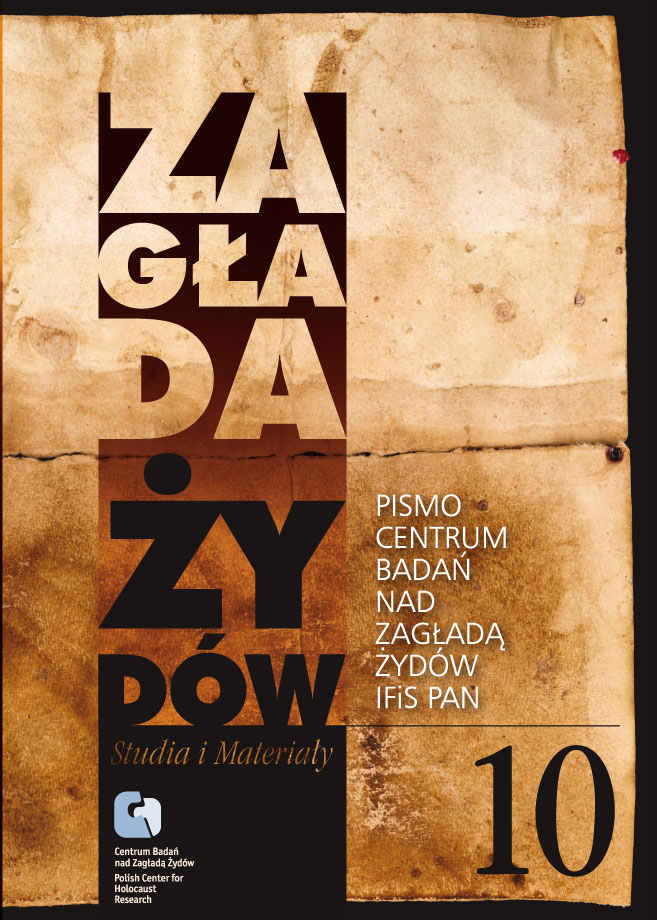Józef Kermisz (1907–2005) – twórca badań nad Szoa
Zagłada Żydów. Studia i Materiały, Nr 10 (2014), Strony: 304-316
Data zgłoszenia: 2020-10-22Data publikacji: 2014-12-01
 https://doi.org/10.32927/ZZSiM.526
https://doi.org/10.32927/ZZSiM.526
Abstrakt
Józef Kermisz (1907–2005) was a historian and an archivist who helped lay the foundations for Shoah research in Poland and Israel. In 1944 joined the Central Jewish Historical Commission where became the chief archivist. Since then his life has been devoted to retrieving wartime archival material. As archive director (in the Jewish Historical Institute in Poland and at Yad Vashem in Israel) he sought to develop an archive both for future historical research and for trials of suspected war criminal. He played a major role in discovering and preserving important documentation on the Shoah in Poland. Among his major professional achievements were preparing documentation for the prosecution in the Eichmann trial, and publishing Czerniakow’s diary and the full edition of the underground press of the Warsaw ghetto. He was one of the world’s leading experts on the Ringelblum Archive and other hidden Jewish documentation from the Holocaust. Kermisz left behind a legacy of a vast research infrastructure that he created and that will occupy scholars for generations.
Licencja
Prawa autorskie (c) 2014 Autor&"Zagłada Żydów. Studia i Materiały"

Utwór dostępny jest na licencji Creative Commons Uznanie autorstwa 4.0 Międzynarodowe.
https://creativecommons.org/licenses/by/4.0
Czasopismo publikowane jest w standardzie Diamond Open Access na licencji CC-BY-4.0 Deed - Uznanie autorstwa 4.0 Międzynarodowa - Creative Commons
Inne teksty tego samego autora
- Avner Shalev, Dan Michman, David Silberklang, Ścisła pamięć o Zagładzie w Muzeum Historii Holokaustu w Yad Vashem. Odpowiedź na artykuł Amosa Goldberga , Zagłada Żydów. Studia i Materiały: Nr 7 (2011)
Podobne artykuły
- Dariusz Libionka, Z getta warszawskiego przez Francję i Hiszpanię do Londynu. Niewiarygodna historia Edwarda Rajnfelda-Tohariego , Zagłada Żydów. Studia i Materiały: Nr 18 (2022)
- Magdalena Semczyszyn, Żydzi w sowieckich oddziałach partyzanckich na północno-wschodnich terenach Drugiej RP 1941–1944 – zarys problematyki , Zagłada Żydów. Studia i Materiały: Nr 17 (2021)
- Karolina Panz, Zagłada sztetl Grice , Zagłada Żydów. Studia i Materiały: Nr 3 (2007)
- Barbara Engelking, Sny jako źródło do badań nad Zagładą , Zagłada Żydów. Studia i Materiały: Nr 9 (2013)
- Sławomir Buryła, Kertzer David, Papieże a Żydzi , Zagłada Żydów. Studia i Materiały: Nr 2 (2006)
- Natalia Aleksiun, Melanie Hembera, Die Shoah im Distrikt Krakau Jüdisches Leben und deutsche Besatzung in Tarnów 1939–1945 , Zagłada Żydów. Studia i Materiały: Nr 13 (2017)
- Barbara Engelking, “Germans have killed our Jews, so we’re getting rid of them.” The case of Edward Toniakiewicz , Zagłada Żydów. Studia i Materiały: Nr Holocaust Studies and Materials (2017)
- Piotr Forecki, Anna Zawadzka, The Golden Mean Principle. A Handful of Comments on the Currently Dominant Discourse on ‘Polish-Jewish Relations’ , Zagłada Żydów. Studia i Materiały: Nr Holocaust Studies and Materials (2017)
- Przemysław Czapliński, Wirus Auschwitz , Zagłada Żydów. Studia i Materiały: Nr 10 (2014)
- Przemysław Czapliński, The Auschwitz Virus , Zagłada Żydów. Studia i Materiały: Nr Holocaust Studies and Materials (2017)
<< < 12 13 14 15 16 17 18 19 20 21 22 23 24 25 26 27 28 29 30 31 32 33 34 35 36 37 38 39 40 41 42 43 44 45 46 47 48 49 50 51 52 53 54 55 56 57 58 59 60 61 > >>
Możesz również Rozpocznij zaawansowane wyszukiwanie podobieństw dla tego artykułu.
 English
English
 Język Polski
Język Polski




